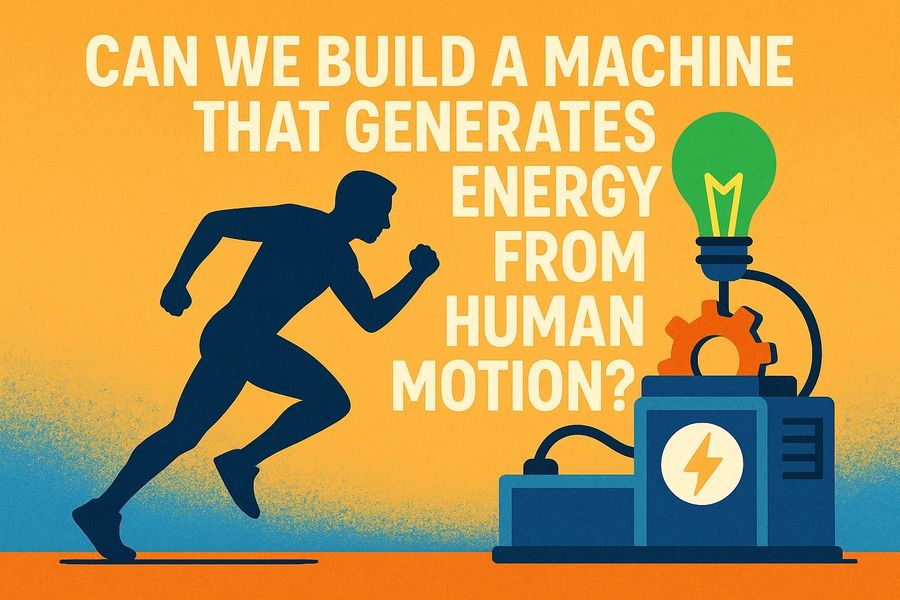Imagine charging your phone just by walking to work, running on a treadmill, or even typing on a keyboard. Sounds futuristic? It’s not — it’s entirely scientifically possible and already happening in some parts of the world.
Humans produce energy constantly, especially through motion. With the right technology, we can capture this kinetic energy and turn it into usable electricity. In this article, we’ll explore the fascinating world of energy-harvesting machines powered by human movement. We’ll delve into the science, examples of existing technology, and what it would take to build such a machine efficiently. 🚶♀️⚙️⚡
🧠 The Science Behind It: Converting Motion Into Electricity
The core concept is simple: mechanical energy from movement is converted into electrical energy through various mechanisms. This is typically done via one of the following methods:
1️⃣ Electromagnetic Induction
When a magnet moves through a coil, it generates a current — the principle behind generators and dynamos.
🧲➡️🔁➡️⚡
Used in:
-
Pedal-powered generators
-
Hand-crank chargers
-
Some wearable tech
2️⃣ Piezoelectric Effect
Certain materials generate an electric charge when compressed, stretched, or deformed.
📏➡️🔋
Used in:
-
Pressure-sensitive floor tiles
-
Shoe soles
-
Vibration sensors
3️⃣ Triboelectric Nanogenerators (TENGs)
A cutting-edge field where friction between materials creates charge transfer — like rubbing a balloon on your hair.
Used in:
-
Wearable electronics
-
Motion-tracking gloves
-
Smart clothing
💪 Human Body as an Energy Source
Every human is a walking energy factory. Consider these approximate energy outputs:
-
Walking: 100–200 watts
-
Cycling: 150–400 watts
-
Running: 400–800+ watts
-
Typing or arm movement: 1–10 watts
To put that in perspective:
-
Charging a smartphone: ~5 watts
-
Powering a 60W bulb: walking continuously for 30–40 minutes
-
Boiling water: much more effort required!
So, while we can’t run a house off a treadmill (yet), we can build machines that store or use energy from motion in small, practical ways.
🔧 Types of Machines That Harvest Human Motion
🚴 1. Pedal Generators
Stationary bikes or foot-pedal setups with a connected dynamo can generate electricity as you pedal.
Applications:
-
Charging phones in off-grid areas
-
Educational demos
-
Emergency power backups
🖐️ 2. Hand-Crank Devices
These simple devices convert manual effort into short bursts of power.
Applications:
-
Emergency radios
-
Flashlights
-
Portable chargers
👟 3. Energy-Generating Footwear
Walking compresses soles embedded with piezoelectric materials, producing small amounts of energy.
Applications:
-
Lighting LEDs in shoes
-
Charging small batteries
-
Powering fitness trackers
🧥 4. Wearable Kinetic Energy Harvesters
Wristbands, smartwatches, and backpacks that generate power from arm swings or movement.
Applications:
-
Powering sensors or fitness monitors
-
Emergency beacons for hikers
🚶♂️ 5. Motion Floors & Mats
Public spaces fitted with pressure-sensitive tiles can generate energy from foot traffic.
Applications:
-
Lighting signs or displays
-
Collecting data in crowded areas
-
Smart city infrastructure
🏗️ Could We Build a Full-Scale Machine?
Yes, but the practicality depends on purpose, efficiency, and scale.
✅ What We Can Build Now:
-
Compact human-powered generators (hand cranks, pedal devices)
-
Self-charging wearables
-
Piezoelectric sensors in clothing and shoes
-
Kinetic floors for public buildings
🚧 What’s Challenging:
-
Energy density: Human motion generates relatively small amounts of power
-
Storage: Requires batteries or capacitors
-
Cost: Miniaturized harvesting tech is still expensive
-
Durability: Wearables and surfaces face wear and tear
For everyday use, we can supplement power needs, not fully replace the grid.
🌍 Real-World Examples of Human-Powered Technology
| Tech/Product | How It Works | Application |
|---|---|---|
| Soccket Ball ⚽ | Generates power while being kicked | Off-grid lighting for children in remote areas |
| PowerTrekk Backpack 🎒 | Uses walking to power devices | Military and remote travel |
| Pavegen Tiles 🚶 | Floor tiles that generate power from footsteps | Airports, shopping centers, and train stations |
| WeWatt Desks 🪑 | Pedal desks that generate energy for devices | Offices and libraries |
| AMPY Move ⌚ | Wearable charger powered by body movement | Fitness tracking and device charging |
These examples show that energy from human movement is a growing field, blending engineering, environmental awareness, and smart design.
🧠 Key Components for a Human-Motion Energy Machine
To build one yourself, here’s what you’d need:
| Component | Purpose |
|---|---|
| Mechanical Input | Pedals, cranks, steps, or movement sensors |
| Generator | Converts kinetic energy into electricity |
| Rectifier Circuit | Turns AC into usable DC current |
| Battery/Capacitor | Stores the energy generated |
| Voltage Regulator | Delivers stable output to devices |
These can be combined into compact systems that power:
-
USB devices
-
LEDs
-
Radios or fans
-
IoT sensors
With creativity and some engineering knowledge, you can DIY one for camping or off-grid living. 🔋🛠️
🧾 Conclusion: The Power in Every Step
Yes, we can build machines that generate energy from human motion! 💪⚡ While these devices won’t replace your local power plant, they offer exciting, eco-friendly ways to power small electronics, promote sustainability, and even improve emergency preparedness.
From kinetic sidewalks to energy-harvesting wearables, the future of human-powered tech is promising — and it’s already making an impact. All it takes is a step in the right direction… literally! 👣💡


